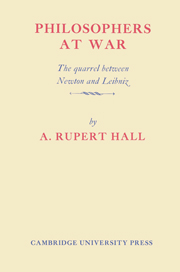Book contents
- Frontmatter
- Contents
- Preface
- Chronological Outline
- 1 Introduction
- 2 Beginnings in Cambridge
- 3 Newton states his claim: 1685
- 4 Leibniz encounters Newton: 1672–1676
- 5 The emergence of the calculus: 1677–1699
- 6 The outbreak: 1693–1700
- 7 Open warfare: 1700–1710
- 8 The philosophical debate
- 9 Thrust and parry: 1710–1713
- 10 The dogs of war: 1713–1715
- 11 War beyond death: 1715–1722
- Appendix: Newton's “Account of the Book entituled Commercium Epistolicum”
- Notes
- Index
9 - Thrust and parry: 1710–1713
Published online by Cambridge University Press: 16 October 2009
- Frontmatter
- Contents
- Preface
- Chronological Outline
- 1 Introduction
- 2 Beginnings in Cambridge
- 3 Newton states his claim: 1685
- 4 Leibniz encounters Newton: 1672–1676
- 5 The emergence of the calculus: 1677–1699
- 6 The outbreak: 1693–1700
- 7 Open warfare: 1700–1710
- 8 The philosophical debate
- 9 Thrust and parry: 1710–1713
- 10 The dogs of war: 1713–1715
- 11 War beyond death: 1715–1722
- Appendix: Newton's “Account of the Book entituled Commercium Epistolicum”
- Notes
- Index
Summary
Keill's offensive remarks in his Philosophical Transactions paper of (officially) 1708 were too much for Leibniz's patience. He felt that the time had come to demand redress, and so raised the dispute to the level of international diplomacy by formally protesting, as a Fellow, to the Royal Society against Keill's conduct in a letter of 21 February 1711, in which he demanded that Keill should apologize for his libelous insinuations. Newton himself, Leibniz alleged, had discountenanced such “misplaced zeal of certain persons on behalf of your nation and himself” when Fatio de Duillier had first attacked Leibniz as a plagiarist; Fatio had then collapsed without support and clearly Leibniz expected that Keill would do the same, especially under pressure from the Royal Society, which would be conscious of Leibniz's dignity, distinction, and influence even if Keill himself were not. Leibniz's letter to Hans Sloane, the secretary of the Royal Society, rings with a genuine note of injured innocence; he had, he wrote, never heard “the name calculus of fluxions spoken nor seen with these eyes the symbolism that Mr Newton has employed before they appeared in Wallis's Works.”
- Type
- Chapter
- Information
- Philosophers at WarThe Quarrel between Newton and Leibniz, pp. 168 - 201Publisher: Cambridge University PressPrint publication year: 1980
- 1
- Cited by

